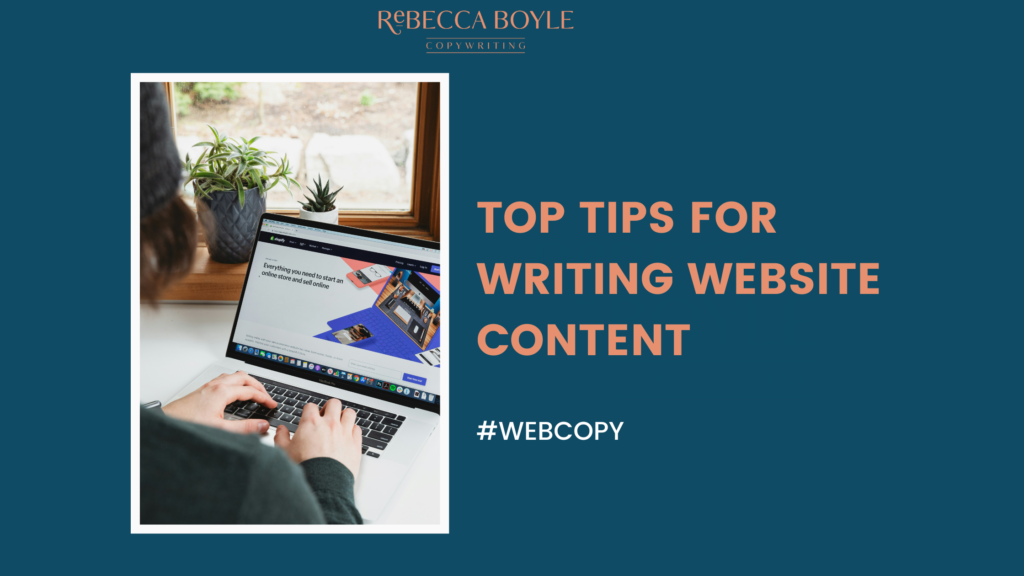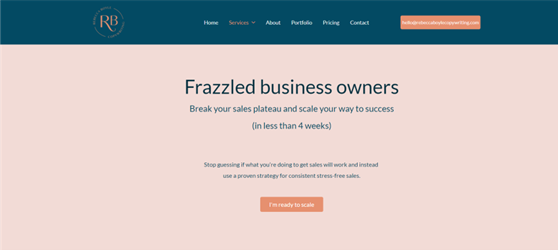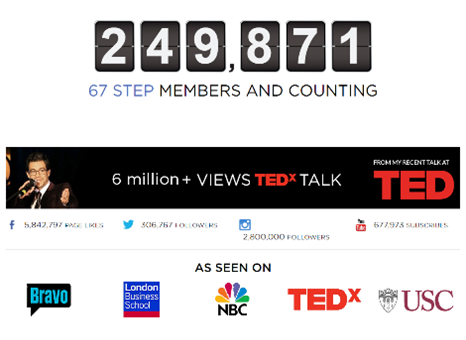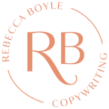
Wouldn’t it be nice if customers came to you instead of you spending hours trying to find quality leads?
Well, it’s possible.
Your website can sit like a relic in the attic, doing nothing.
Or it can act like a 24/7 salesperson helping to convert leads.
One of the most important ways to make sure it is doing its job is to get clear, confident, and in control of your copy.
Keep reading to find out how to create great copy for your website and how one business increased their conversion rate by 68% by adding this one thing to their website.
Why your web copy is so important?
If you want more visitors to your site and to convert more leads, updating your copy may be the answer.
Simply by improving the quality and value of your content, 44% of respondents in a Semrush survey said it led to success.
Plus, compelling copy draws 7.8 x more site traffic and it produces better brand recall.
What content should be on my homepage?
Hold your horses.
Before you start writing one word for your homepage, you need to do some research so you can better reach your audience.
Customer analysis
Clients often ask me, “Do I need to speak like my customers?”
My answer: No, you don’t.
But it helps to incorporate their language into your copy so your words resonate with them.
People buy from people they like and can relate to. So, show them you are like them (as long as you are, there’s no point pretending).
Thoroughly research your customers by interviewing existing customers or competitors’ customers.
Look at publications they read, or visit specialist and regular forums like Reddit.
And it’s not just about understanding their demographic, such as gender, race, and hobbies; it’s about understanding what they all have in common. What do they value? What’s the common theme among them?
This will help you create copy that speaks to your ideal audience.

Competitors
What are your competitors doing?
If you don’t already know, stop what you’re doing and go find out.
What channels are they using to market?
How regularly do they post on social media, and which posts get the best engagement?
What keywords are they using, if any?
To stand out from your competitors, you need to know what they’re doing so you can do it differently.
That doesn’t mean you have to do the opposite, but you have to ensure you’re offering something they’re not.
Thoroughly research your competitors by finding out everything you can, including what their customers say about them.
USP
What’s unique about your business?
And don’t tell me you’re the cheapest or you offer a package that no one else does.
Because that’s not the right answer.
The thing that is unique about your business is what people can get from you that they can’t get anywhere else.
There will always be a competitor who can offer your product or service cheaper or with more bells and whistles.
Your unique selling point (USP) is something no one can copy.
A lot of business owners don’t spend enough time thinking about this, but figuring out what your USP is will be vital to your marketing and business in general.
You are laying the foundation of your business here, and if you don’t get it right, it could cause you to lose sales.
A ‘lack of message’ was cited as the main reason 46% of users left a website.
You want visitors to be able to tell what you do, what you can do for them, and what’s so great about you within seconds of landing on your website.
Navigation
People can’t remember more than 7 things at a time .
Which is why you probably shouldn’t have more than 7 categories in your navigation menu (not to mention avoiding clutter).
You can always use drop-down menus for other pages, but you want to highlight the main categories on your navigation and nothing more.

Headline
On average, 8 out of 10 people read the headline copy, but only 2 out of 10 will read the rest.
You should spend most of your time creating your headline because traffic can vary by as much as 500% based on it.
Your customers are busy people, often functioning on autopilot, with many thoughts occupying their minds. Your headline needs to grab their attention and wake them up.
Tips for creating an attention-grabbing headline:
· Call out your audience
· Use ‘how to’ headlines
· Ask a question and create curiosity
· Use an odd number (odd numbers, for some reason, get better engagement than even).

Social proof
Social proof is a great way of showing you know what you’re doing.
It could be anything from testimonials or logos of businesses you’ve worked with to stats on how many people have bought from you or your rating on review sites.
The most effective social proof comes from your customers, as 72% of consumers find customer-submitted reviews and testimonials more trustworthy than brands talking about their own products.
Showcasing social proof high up on the page helps to give authority to the rest of the copy on the page.
Augmentive, a wellbeing app, included social proof under its landing page button, and it helped increase its conversion rate by 68%.
And please, please, don’t have statements on your website such as ‘We’re the best law firm in New York’.
Yes, I do actually see people do this.
And no, no one will believe you.
How have you measured you’re the best? And if you are, why is your company saying it and not your customers?
Don’t make my eye twitch, people, by doing this.

CTA
A call to action (CTA) is a button on your website that takes visitors to another page.
While they may be small, their impact can be mighty.
ContentVerve saw a 90% increase in their click-through rate by using first-person phrasing.
They used ‘Start my free 30-day trial’ instead of ‘Start your free 30-day trial’.
The change of that one word made the readers feel more involved.
Which is why personalising CTAs can increase your conversions by 202%.
So, instead of using a generic ‘shop now’, you could use ‘shop our cleaning products’.
Not only does this help with conversions, but you can get your keywords in, too.
You can also add your benefit to your CTA copy.
Canva increased its click-through rate by 28% when it changed its button text to include the benefit of its tool.
Instead of having, “Start the free tutorial”, they changed it to, “Unlock my design skills”.
This is also known as a ‘call to value’ button.
For example, instead of a job site using ‘Create my resume’, they could write, ‘Get your dream job’.
Or, instead of a customer engagement tool using ‘Talk to sales’, they could write, ‘Create loyal customers’.
Images
People are highly visual, so it’s important to break up your copy with images.
And you’ll likely get better results if they’re not stock images.
An eye-tracking study found users pay close attention to photos or images that contain relevant information and ignore fluffy pictures.
We all want human connection, so it’s no surprise authentic images of people instead of generic ones get more interest.
And don’t forget to add in your image alt text. This is a description of your image for those who are visually impaired. Where possible, you can also add your keywords to help boost your SEO.
Copy
Don’t use boring B2B speak on your website. Please, I beg you.
You may be selling to a business, but it’s an actual human being making the buying decision.
And although they may understand the jargon you’re using, it doesn’t make for a thrilling read.
They’re not reading a White Paper; they’re reading web copy that needs to be direct, clear, and provides all the information they need.
Get to the point. And quickly.
Because 86% of people want to see product or service information on your website homepage.
So, make this one of the first sections on your homepage.

Proofread
Are there spelling or grammar errors on your website?
If so, you could be losing nearly 9 in 10 more visitors because of typos.
Typos can look unprofessional and give the impression that if you don’t care about what you’re putting in front of your audience, then you probably don’t care about customer service and everything that goes on in the background.
They can also make your website seem untrustworthy. Typos can be a sign of a fraudulent website, and if people don’t know you, then how do they know your website isn’t a scam?
That’s an impression you definitely don’t want to give, so get someone else to look over it. Even as a copywriter, I get my proofreader to look over my copy to ensure my work looks professional.
Keywords
It’s all well and good creating amazing website copy, but it’s not so great if no one sees it.
That’s where SEO comes in.
Adding relevant keywords to your copy can help your ideal audience find you and search engines rank you higher.
Create a database of keywords and assign target keywords to each page of your website.
Measure
Once you’ve written your web copy, unfortunately, you can’t just sit back and enjoy your hard work.
You need to continually direct people to it and keep it up to date.
That’s why it’s important to measure the metrics for your website.
If you’ve a high bounce rate, you might need to change your copy because people aren’t finding what they’re looking for.
If people aren’t taking the actions you want them to, you may need to persuade them to move along your sales pipeline.
When you measure your metrics, you will understand your customers better and be able to create copy that resonates with them.
Writing copy that converts
Creating copy that persuades your visitors to take action is vital to creating a website that sells for you.
If you want help creating copy for your website, you can download my FREE Homepage Checklist.
